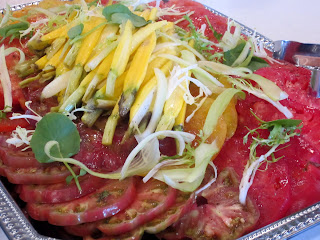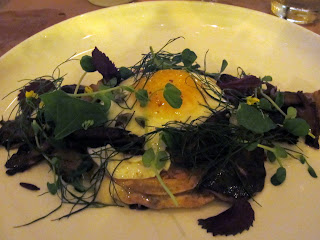
Roasting the tomatoes and onions takes forethought, but what I like to do is just make up big batches of these tomatoes and onions, as well as other versatile ingredients like basil oil, and then keep them in the fridge until I need them. They are so easy to incorporate into a variety of dishes that they are well worth having on hand. For instance, roasted tomatoes work great with pasta, salad, on toasted baguettes, drizzled with balsamic as a tapa, as an accompaniment to roast chicken or lamb chops, or simply eaten right out of the tupperware (yes, I have done that on a few occasions). So my recommendation is to buy a big bag of super ripe tomatoes at the farmers' market, eat a few of them fresh, and then roast the rest for use throughout the week. Same goes for basil oil (see my other blog posts for ideas) and balsamic red onions (but the farmers' market part is optional; I can't say I taste a difference in flavor in onions).
In addition to being a perfect elegant luncheon dish or even (in smaller portions) a nice start to a dinner, this salad makes excellent leftovers.
Farro Salad with, Avocado Dressing, Slow Roasted Tomatoes, Balsamic Red Onions, Fresh Mozzarella, and Microgreens
serves 4
1 cup uncooked farro
Kosher salt
freshly ground pepper
1 very ripe avocado, diced
about 12 roasted tomato halves (see recipe below)
about 1 cup balsamic red onions (see recipe below)
2 balls fresh mozzarella, sliced
1 cup micro greens (I suggest sunflower sprouts--they have a delicious nutty taste and some nice crunch)
1/4 cup basil oil (see recipe below)
Bring a large pot of salted water to a boil over high heat. Add the farro and cook, stirring occasionally, for about 30 minutes, and then pour into a strainer and rinse with cold water. The farro should be fully cooked but still have some chewiness to it.
When the farro is close to room temperature, toss with the salt and pepper in a large mixing bowl. Add the avocado, and use your (clean) hands to work the avocado into a sort of dressing. You should be squeezing the avocado around the farro, so eventually the farro is all coated. If the avocado is less soft, add a bit of olive oil to complete the dressing.
Arrange the farro mixture on four plates. Build the salad up by layering the tomatoes, onions, and mozzarella slices on top of the farro. Drizzle the basil oil equally on the four salads. Top with the greens, and serve immediately.
Roasted Tomatoes
2 pounds small fresh tomatoes, halved lengthwise
1/2 teaspoon to 1 teaspoon Kosher salt
1/4 teaspoon freshly ground pepper
2 tablespoons sugar (add more if the tomatoes aren't sweet)
1 tablespoon fresh thyme leaves
Preheat oven to 225 degrees F. Toss all ingredients to coat the tomatoes. Arrange the tomatoes cut side up in a shallow baking dish. Roast for 3 hours.
Balsamic Red Onions
2 pounds red onions, thinly sliced (slice in rings, or slice root to tip--whatever you prefer the look of)
1/2 cup balsamic vinegar
2 tablespoons sugar
1 teaspoon Kosher salt
1/4 teaspoon freshly ground pepper
Preheat the oven to 450 degrees F. Toss all ingredients together in a shallow baking dish to coat the onions. Roast for 30 minutes or until the onions are soft.
Basil Oil
makes around 1 cup
2 big bunches fresh basil leaves
3/4 cup olive oil, approximately
salt and pepper, to taste
In a food processor, pulse the basil leaves until they are chopped. Start adding the olive oil in a steady stream until the mixtures reaches a texture much looser than a pesto. Adjust the amount of olive oil based on how thick you want the basil oil to be. When the texture is right, add salt and pepper to taste and process for another few seconds or until smooth enough.
Let the oil sit at room temperature for 15 minutes to allow the flavors to meld. After this, basil oil keeps in the refrigerator for 3 days to a week (after this it will still be good, but not as flavorful).
makes around 1 cup
2 big bunches fresh basil leaves
3/4 cup olive oil, approximately
salt and pepper, to taste
In a food processor, pulse the basil leaves until they are chopped. Start adding the olive oil in a steady stream until the mixtures reaches a texture much looser than a pesto. Adjust the amount of olive oil based on how thick you want the basil oil to be. When the texture is right, add salt and pepper to taste and process for another few seconds or until smooth enough.
Let the oil sit at room temperature for 15 minutes to allow the flavors to meld. After this, basil oil keeps in the refrigerator for 3 days to a week (after this it will still be good, but not as flavorful).













































